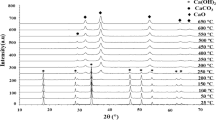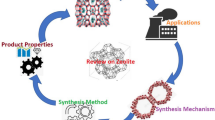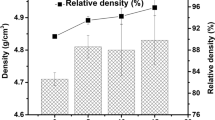Abstract
We have developed technological principles of the preparation of ultrafine and nanosized MoSi2 particles by self-propagating high-temperature synthesis (SHS) with a reduction step. The effect of synthesis conditions (starting-mixture composition, relative amounts of reactants, and the presence and amount of an inert diluent) on the composition, structure, and particle size of the powders has been studied. The results demonstrate that inert additives reduce the adiabatic temperature. The crystallite size of MoSi2 decreases with increasing additive concentration. The MoSi2 powders obtained by SHS with a reduction step have the form of agglomerates consisting of spherical particles ranging widely in size: from large (several microns) to ultrafine and nanosized. The composition of the powders was checked by chemical analysis, microstructural examination, and X-ray diffraction.
Similar content being viewed by others
References
Stoloff, N.S., Liu, C.T., and Deevi, S.C., Emerging applications of intermetallics, Intermetallics, 2000, vol. 8, pp. 1313–1320.
Waghmare, U.V., Kaxiras, F., and Duesbery, M.S., Modeling brittle and ductile behavior of solids from first-principles calculations, Phys. Status Solidi, 2000, vol. 217, no. 1, pp. 545–564.
Wirkus, C.D. and Wilder, D.R., High temperature oxidation of molybdenum disilicide, J. Am. Ceram. Soc., 1966, vol. 49, no. 4, pp. 173–177.
Vasudevan, A.K. and Petrovic, J.J., A comparative overview of molybdenum disilicide composite, Mater. Sci. Eng., A, 1992, vol. 155, pp. 1–17.
Petrovic, J.J., High temperature structural silicides, Ceram. Eng. Sci. Proc., 1997, vol. 18, pp. 3–17.
Meschter, P.J., Low-temperature oxidation of molybdenum disilicide, Metall. Trans. A, 1992, vol. 23, pp. 1763–1772.
Bertiss, D.A., Cerchiara, R.R., Gulbransen, E.A., et al., Oxidation of MoSi2 and comparison with other silicide material, Mater. Sci. Eng., A, 1992, vol. 155, pp. 165–181.
Shimizu, H., Yoshinaka, M., Hirota, K., and Yamaguchi, O., Fabrication and mechanical properties of monolithic MoSi2 by spark plasma sintering, Mater. Res. Bull., 2002, vol. 37, pp. 1557–1563.
Merzhanov, A.G., Self-propagating high-temperature synthesis, Fizicheskaya khimiya: sovremennye problemy (Physical Chemistry: Current Issues), Kolotyrkin, Ya.M., Ed., Moscow: Khimiya, 1983, p. 8.
Merzhanov, A.G., Combustion: new manifestation of an ancient process, Chemistry of advanced materials, Rao, C.N.R., Ed., Oxford: Blackwell Scientific, 1992, pp. 19–39.
Lagunov, Yu.V., Pikalov, S.N., Kolomoets, G.G, and Mamyan, S.S., Preparation of boron nitride by enriching a reduction step SHS product, Sbornik trudov “Problemy tekhnologii goreniya. Materialy 3-ei vsesoyuznoi konferentsii po tekhnologii goreniya” (Collection of Works Combustion Technology Problems: Proc. 3rd All-Union Conf. on Combustion Technology), Chernogolovka, 1981, vol. 1, pp. 40–42.
Nersisyan, H.H., Lee, J.H., and Won, C.W., SH-synthesis of ceramic powders in the fusion salts of alkali metal, J. Ceram. Process. Res., 2005, vol. 6, no. 1, pp. 41–47.
Chaichana, N., Memongkol, N., Wannasin, J., and Niyomwas, N., Synthesis of nano-sized TiB2 powder by SHS, J. Mater. Sci., 2008, vol. 7, pp. 51–57.
Khara, A.K., Pathak, L.C., and Godkhindi, M.M., Effect of NaCl on the synthesis of TiB2 powder by SHStechnique, Mater. Lett., 2004, pp. 733–738.
Borovinskaya, I.P., Ignat’eva, T.I., Vershinnikov, V.I., et al., Preparation of ultrafine boron nitride powders by self-propagating high-temperature synthesis, Inorg. Mater., 2003, vol. 39, no. 6, pp. 588–593.
Merzhanov, A.G., Kitain, M.M., Gol’dshleger, U.I., and Shteinberg, A.S., Thermodynamic analysis of reactions between iron oxides and a methane-oxygen mixture, Dokl. Akad. Nauk SSSR, 1977, vol. 237, no. 2, pp. 391–396.
Shaw, L. and Abbaschian, R., Chemical states of the molybdenum disilicide surface, J. Mater. Sci., 1995, vol. 30, pp. 5272–5280.
Borovinskaya, I.P., Ignat’eva, T.I., Semenova, V.N., and Kovalev, I.D.. Self-propagating high-temperature synthesis of ultrafine and nanosized molybdenum disilicide particles, Perspekt. Mater., 2012, no. 2, pp. 55–61.
Author information
Authors and Affiliations
Corresponding author
Additional information
Original Russian Text © V.I. Vershinnikov, T.I. Ignat’eva, V.N. Semenova, I.P. Borovinskaya, 2014, published in Neorganicheskie Materialy, 2014, Vol. 50, No. 5, pp. 512–517.
Rights and permissions
About this article
Cite this article
Vershinnikov, V.I., Ignat’eva, T.I., Semenova, V.N. et al. Preparation of ultrafine and nanosized MoSi2 particles by self-propagating high-temperature synthesis with a reduction step. Inorg Mater 50, 473–478 (2014). https://doi.org/10.1134/S0020168514050197
Received:
Published:
Issue Date:
DOI: https://doi.org/10.1134/S0020168514050197




